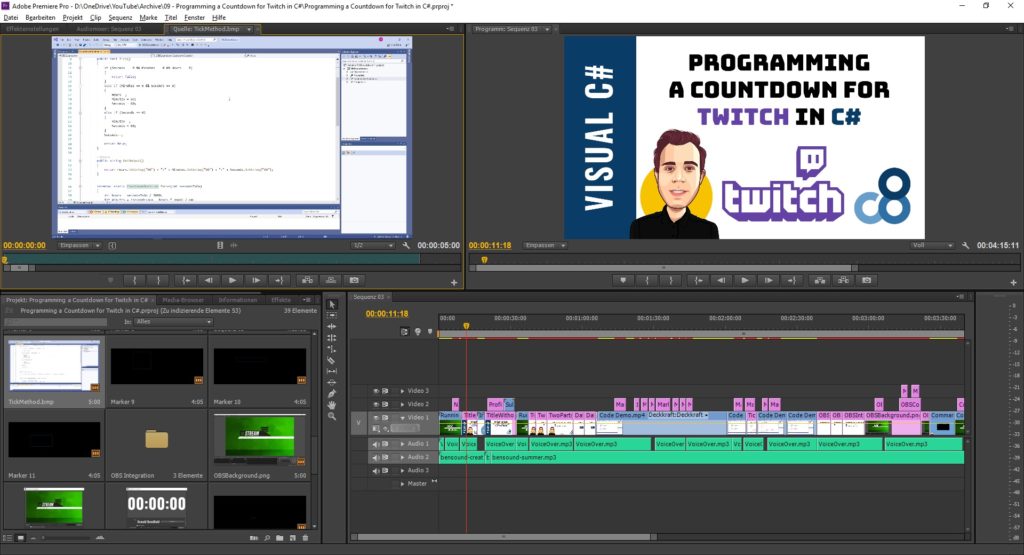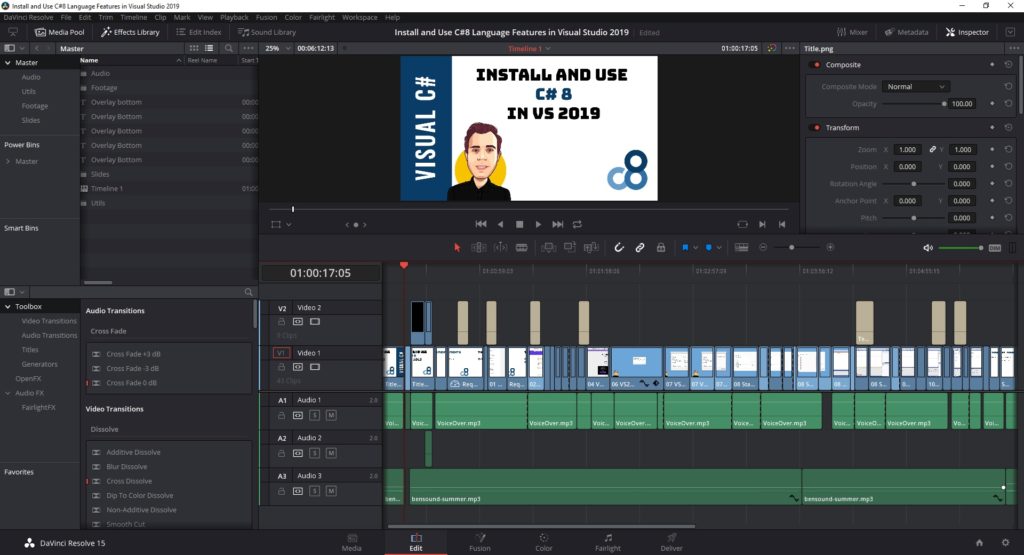People following me closely know that I started my YouTube channel in December 2018, where I upload programming tutorials. Since the launch, I’ve published ten videos to my channel. It’s been an exciting ride, and I’ve learned a lot since I started.
Recently, I decided that it’s time to switch from Adobe Premiere Pro CS6 to DaVinci Resolve 15. In this article, I’ll explain in detail why my decision took a lot of time and why I finally decided to use DaVinci Resolve going forward.
How I Got Started
It’s important to give context about my situation before going into the technical details about the differences between those two software tools.
I had zero video editing experience when I decided to do my first steps in video editing and video production. I had an old Adobe CS6 Suite license, and I am an interested, but not that great Adobe Photoshop CS6 user. Let’s put it like this: I get the job done, most of the time.
So it was an obvious thing for me to take a look at Adobe Premiere Pro CS6.
First Steps with Adobe Premiere Pro Cs6
It was a great experience getting started with Adobe Premiere Pro CS6. First of all, there are many tutorials online, which you can watch for free to gain a basic understanding of how the tool works.
When I got stuck, I googled my problem, and most of the time, I found a video explaining the solution to my question in a short period. It was a great learning experience, and the tool did what I wanted it to do.
The Problems with Adobe Premiere Pro Cs6
The most trouble I had was with the user experience. The Adobe Premiere Pro CS6 version is from 2012, which makes it about seven years old at the time of writing this article.
Some features were hidden; others were expected to be in a different place. I am sure that experienced users do not have this feeling, but for me, as a new user, it was sometimes hard to find the right tools.
Also, I had a hard time finding the correct settings to export the videos in a Full HD format with a viable quality to upload them to YouTube. Maybe it was my inexperience; perhaps it was the tool.
In hindsight, I believe that we both did not do our best to make this a simple task. It took me a few days to figure out the settings I needed. After that, I had a blueprint that worked for all future videos.
I was not sure what I should think about rendering performance. I have a very potent computer, but it took me about 15 minutes to render an 8-minute screencast video with a few text overlays, music, and only a few animations. It felt slow, to be honest.
The biggest problem was that Adobe Premiere Pro CS6 crashed from time to time. There were two different art of crashing. Either the software closed itself, and everything was gone, or certain features stopped working. It took a few seconds to realize that it was not me pressing the wrong buttons, but the software stopped working. I’ve learned to save my work whenever possible, but it was not a great experience.
Looking for Alternatives
After I had created a few videos with Adobe Premiere Pro CS6 I was convinced, I needed a better software. I felt limited.
Adobe Creative Cloud
The most obvious idea was to get the latest version of Adobe Premiere Pro.
As most people know, Adobe has restructured their products, and they are only available through an Adobe Creative Cloud subscription. Because I want to use at least two programs (Premiere Pro and Photoshop), I would have to get a subscription for all applications which costs about 60$ per month in my country.
60$ a month is a lot when you use that software only as a hobby. Let’s say I want to create YouTube videos for the next five years. It would cost me about 3’600$ in total. I am not willing to pay that much.
The next step was to look for an alternative (competitor) product.
Sony Vegas Pro
Sony Vegas Pro is a popular product in the industry, and there are many tutorials on YouTube. It makes Sony Vegas Pro a viable alternative. I did not take a detailed look at all the features.
The payment model includes a single payment option as well as a subscription-based payment method. The price starts at 250$.
Other products
Many other products are available starting from Final Cut Pro to the Windows Movie Maker. You can spend many hours online researching and trying to find the product that matches the best for you.
My criteria were quite simple, I thought. I wanted to get a software that has a high feature ceiling, yet it should be simple to get started. I also wanted to be able to render Full HD at 30 fps, and I wanted to have tutorials available because I am still a beginner when it comes to video editing.
DaVinci Resolve
During my research (also known as searching Google for hours if not days), I stumbled upon DaVinci Resolve. I could not handle the name at first. I thought it might be a Photoshop alternative, but as it turned out, it’s an alternative for the entire Adobe Suite.
DaVinci Resolve not only provides non-linear video editing, animations, color correction, but many more features that I currently do not even know what they do.
I thought it might be an exciting option, and I went to the pricing page. I was shocked. There is a free version available, and most of the features are included with the free version. The DaVinci Resolve Pro costs 300$, which is a very competitive price.
I downloaded the free version, and I immediately was hooked to it. The interface looks clean, and the default settings allow a newbie to export video in a viable format.
As I explored the tool further, I wanted to create my first YouTube video in DaVinci Resolve 15. It turned out I had to relearn a lot of things I’ve learned for Adobe Premiere Pro CS6. The shortcuts are different, some views are different, but in the end, both tools offer the same; video production.
The rendering performance is outstanding. For a 6-minute video that would have taken around 10-15 minutes of rendering time using Adobe Premiere Pro CS 6, I only had about 60s to render in DaVinci Resolve 15.
As I said above, most of my bad experience with Adobe Premiere Pro compared to DaVinci Resolve can be explained with the age of the software. BlackMagic Design gives me a tool with cutting edge technologies for free, whereas Adobe is not able to provide something for a reasonable price.
DaVinci Resolve Resources
I’ve found a few useful resources along the way that I want to share with you in case you want to see if DaVinci Resolve is an option for you, or if you already are a DaVinci Resolve user and want to improve your knowledge.
If you’re new to DaVinci Resolve like I was about four weeks ago, you might want to have a full tutorial on what, how and why you can or should do things the way they work. DaVinci Resolve’s company BlackMagic Design has an excellent tutorial for DaVinci Resolve 15 called Introduction to Editing that I would highly recommend to watch.
- The International Colorist Academy is a small YouTube channel that has about 40 videos, most about DaVinci Resolve. The videos are short and to the point, and it was the How to grade black and white in Resolve video that brought me to this channel.
- Learn DaVinci Resolve is an actively maintained channel with more than 80 videos on DaVinci Resolve 15 and more than 20 videos about DaVinci Resolve 16. They also have videos about older versions and some hardware reviews. I found a few useful videos on this channel, such as Create Title Templates in Fusion.
- Video Editing in a Minute is another channel that has about 40 DaVinci Resolve videos. The one that caught my attention was the How to Fade Text In and Out video.
Summary
In the end, I want to say that I like the Adobe product. Adobe Premiere Pro CS6 was the first video editing software I have used, and I have learned a lot along the way.
It’s not that Adobe Premiere Pro from the Creative Cloud isn’t good enough. It’s their pricing strategy. I could not – or I want not to spend about 60$ a month on a software I use to produce free content in my spare time.
Also using the old version was not a viable solution, as explained in detail in the chapters above. I had to change something.
I am delighted with the experience I have made using DaVinci Resolve 15, and I am keen on learning more about the different editing techniques, the advanced features, color grading, effects, and much more.
I’m also planning on recording videos during my next vacation and cutting a holiday movie from it. Let’s see how that works out.




